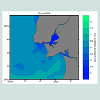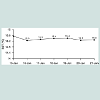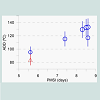Journal of Forensic Investigation
Download PDF
Case Report
*Address for Correspondence: Marcos Mateus, Instituto Superior Técnico, Universidade de Lisboa, Av. Rovisco Pais, 1049-001 Lisboa, Portugal; E-mail: marcos.mateus@tecnico.ulisboa.pt
Citation: Mateus M, Pinto L. Report on the Accumulated Degree Days and Post Mortem Submersion Interval for an Infant Drowning Accident. J Forensic Investigation. 2016; 4(2): 3.
Copyright © 2016 Mateus M, et al. This is an open access article distributed under the Creative Commons Attribution License, which permits unrestricted use,distribution, and reproduction in any medium, provided the original work is properly cited.
Journal of Forensic Investigation | ISSN: 2330-0396 | Volume: 4, Issue: 2
Submission: 24 May, 2016 | Accepted: 19 July, 2016 | Published: 23 July, 2016
 where hi represents the number of hours in each day (i) during the submersion period (n), and Ti the daily temperature [10]. This expression is a modified version of the standard method to calculate ADD [14]. A ± 1.5 °C variation range was assumed for temperature values used to calculate ADD, thus determining the cumulative lower (ADDmin) and upper (ADDmax) limits for ADD, as suggested in [10].Water temperature was retrieved from the Group for High Resolution Sea Surface Temperature (GHRSST) level 4 sea surface temperature analysis product EUR-L4UHRfnd-MED-ODYSSEA, available at http://dx.doi.org/10.5067/GHMOY-4FE01 [May 13, 2016]. This product is generated by merging microwave and infrared satellite sea surface temperature observations to provide daily cloudfree field sea surface temperature at approximately 2 km resolution (0.02 degree) for the Mediterranean Sea and the West Iberian Coast.
where hi represents the number of hours in each day (i) during the submersion period (n), and Ti the daily temperature [10]. This expression is a modified version of the standard method to calculate ADD [14]. A ± 1.5 °C variation range was assumed for temperature values used to calculate ADD, thus determining the cumulative lower (ADDmin) and upper (ADDmax) limits for ADD, as suggested in [10].Water temperature was retrieved from the Group for High Resolution Sea Surface Temperature (GHRSST) level 4 sea surface temperature analysis product EUR-L4UHRfnd-MED-ODYSSEA, available at http://dx.doi.org/10.5067/GHMOY-4FE01 [May 13, 2016]. This product is generated by merging microwave and infrared satellite sea surface temperature observations to provide daily cloudfree field sea surface temperature at approximately 2 km resolution (0.02 degree) for the Mediterranean Sea and the West Iberian Coast.
Report on the Accumulated Degree Days and Post Mortem Submersion Interval for an Infant Drowning Accident
Marcos Mateus* and Ligia Pinto
- Instituto Superior Técnico, Universidade de Lisboa, Portugal
*Address for Correspondence: Marcos Mateus, Instituto Superior Técnico, Universidade de Lisboa, Av. Rovisco Pais, 1049-001 Lisboa, Portugal; E-mail: marcos.mateus@tecnico.ulisboa.pt
Citation: Mateus M, Pinto L. Report on the Accumulated Degree Days and Post Mortem Submersion Interval for an Infant Drowning Accident. J Forensic Investigation. 2016; 4(2): 3.
Copyright © 2016 Mateus M, et al. This is an open access article distributed under the Creative Commons Attribution License, which permits unrestricted use,distribution, and reproduction in any medium, provided the original work is properly cited.
Journal of Forensic Investigation | ISSN: 2330-0396 | Volume: 4, Issue: 2
Submission: 24 May, 2016 | Accepted: 19 July, 2016 | Published: 23 July, 2016
Abstract
A limited number of forensic studies report on the Post Mortem Submersion Interval (PMSI) and the related Accumulated Degree Days (ADD) necessary for a body to resurface after drowning. Some of these studies result from experiments using animal carcasses. Death by drowning represents the only source of PMSI and ADD information for human corpses. Since there are ethical and legal constraints to experiments with human corpses, gathering this information relies on reports of drowning accidents. This case study focuses on estimated ADD and PMSI for a 3-year old drowning victim. The PMSI was 5.6 days, during which the water temperature varied between 15.3 °C and 15.6 °C. Calculated interval for the ADD range was between 76 °C and 92 °C. Insignificant body drift occurred despite the highly hydrodynamic regime of the accident area. The findings here reported were compared with previous published data for similar cases, showing similar drift patterns and PMSI but a lower ADD threshold for the body to regain floatability.Keywords
Drowning; Accumulated degree days; Post mortem submersion interval; Forensic oceanographyIntroduction
The information on the Accumulated Degree Days (ADD) necessary for a human corpse to resurface has been mostly derived from studies with animal carcasses as analogues to human bodies [1-4]. Reports on ADD for humans are scarce, and drowning accidents are usually the only source of information [5-10]. Consequently, submersion deaths for which the Post Mortem Submersion Interval (PMSI) and water temperature for this period are known provide information that can later be used in both forensic analysis and in search and rescue efforts for body recovery after accidents, homicides or suicides in aquatic systems [5,11,12]. The values for ADD and PMSI found in the literature for drowning cases comprise both salt and freshwater environments. Most studies emphasize the role of temperature on the decomposition process, avoiding the additional complexity of tackling the influence of water salinity. However, the influence of salinity should be based in mind when comparing ADD and PMSI across different aquatic systems.In this report we address a homicide case resulting in the death by drowning of a 3-year old girl and focuses on ADD (based on water temperature at the site) and PMSI. We briefly discuss the results by comparing our observations with the results reported in other drowning studies for older victims in marine environments, given the lack of data on ADD and PMSI for similar cases (age approximated) [8,10]. We emphasize, however, that the remains from a child with such a small body height and weight may have a different specific gravity from adults, resulting in distinct floatability behaviour [13].
Case Report
On 15 February 2016 at approximately 2000 h (Western European Winter Time) a 3-year old girl was apparently drowned by her mother at Giribita beach (38°41’52’’ N; 9°16’56’’ W), located near the mouth of the Tagus estuary (Figure 1). On 21 February 2016, at around 0930 h, the body of the girl was spotted floating a few meters from the place of drowning and recovered. Death by drowning was confirmed by autopsy. The elements for this description of events were taken from broadcasted and printed media coverage of the event.The Giribita beach is located in the North margin of the Tagus estuary mouth. It is a sand beach of approximately 150 m with a W - E orientation, bordered by rocky structures. Tide is semidiurnal with amplitude of about 3 m. The local water circulation is mainly controlled by tidal action, river discharge and wave regime. These combinations of factors impose significant variation in time of the direction and intensity of local currents.Methods
PMSI was calculated from dates obtained from popular media coverage. The exact moment of the drowning is known from eyewitnesses. Also, given the hour and confluence of people at the beach, it is assumed that the resurfacing moment happened around the same time the body was spotted floating a few meters from the beach.ADD was calculated based on Sea Surface Temperature (SST) according to
 where hi represents the number of hours in each day (i) during the submersion period (n), and Ti the daily temperature [10]. This expression is a modified version of the standard method to calculate ADD [14]. A ± 1.5 °C variation range was assumed for temperature values used to calculate ADD, thus determining the cumulative lower (ADDmin) and upper (ADDmax) limits for ADD, as suggested in [10].Water temperature was retrieved from the Group for High Resolution Sea Surface Temperature (GHRSST) level 4 sea surface temperature analysis product EUR-L4UHRfnd-MED-ODYSSEA, available at http://dx.doi.org/10.5067/GHMOY-4FE01 [May 13, 2016]. This product is generated by merging microwave and infrared satellite sea surface temperature observations to provide daily cloudfree field sea surface temperature at approximately 2 km resolution (0.02 degree) for the Mediterranean Sea and the West Iberian Coast.
where hi represents the number of hours in each day (i) during the submersion period (n), and Ti the daily temperature [10]. This expression is a modified version of the standard method to calculate ADD [14]. A ± 1.5 °C variation range was assumed for temperature values used to calculate ADD, thus determining the cumulative lower (ADDmin) and upper (ADDmax) limits for ADD, as suggested in [10].Water temperature was retrieved from the Group for High Resolution Sea Surface Temperature (GHRSST) level 4 sea surface temperature analysis product EUR-L4UHRfnd-MED-ODYSSEA, available at http://dx.doi.org/10.5067/GHMOY-4FE01 [May 13, 2016]. This product is generated by merging microwave and infrared satellite sea surface temperature observations to provide daily cloudfree field sea surface temperature at approximately 2 km resolution (0.02 degree) for the Mediterranean Sea and the West Iberian Coast.Results and Discussion
The calculated PMSI was 5.6 days, and the ADD was 84 °C, estimated from the sea surface temperature. The observed temperature at the accident site for this period showed little variation, despite the influence of both estuarine and oceanic waters. Temperature ranged between ~16 °C in the first day (Figure 1), and 15.3 °C in the last day of the PMSI, as illustrated in Figure 2. Lower (ADDmin) and upper (ADDmax) limits for ADD were 76 °C and 92 °C respectively.Body displacement was minimal, suggesting insufficient drag force to transport the body, or that the swell or oceanographic conditions kept the body close to the coast [9,15]. Similar observations have been reported previously as well as highly variable outcomes, where bodies have been recovered at a considerable distance from the point of entry [7,8,10,16]. These strikingly different patterns suggest that body drift occurs after flotation is regained. In the case addressed here, the drowning occurred near a public area which probably led to an immediate spotting of the body after resurfacing, before it drifted away due to the surface circulation.The PMSI ends with the regaining of buoyancy of corpses, processes determine by the fundamental laws of physics. This process depends on a number of victim and environmental factors [12]. The decomposition process, leading to the bloating stage, can be considered as most relevant factor involved in the resurfacing of drowned victims [13,15]. The physical process underlying this occurrence is the change in the specific gravity, the relationship between the density of the body and surrounding water density that decreases as gases are produced during decomposition, ultimately leading to the body to regain flotation [10].
Water temperature determines the duration of the PMSI because it has a direct influence on decomposition rate the leads to the gain of floatability [17]. A variation in the cumulative thermal effect, expressed in the ADD, is expected amongst drowning cases. However, published data suggest the existence of a threshold for the body to regain floatability [8,10]. In this study, the calculated ADD was 84 °C, with a possible range between 76 °C and 92 °C assuming error estimates in the remote sensing, as were explained in the methodology section. When compared with previous reported cases, this range is lower, as seen in Figure 3, which illustrates some of the variation in the relationship between PMSI and ADD. It is possible to notice that most observation show a PMSI > 7 days. Some estimations show PMSI up to 12 days [14]. However, at least one reported case matches the PMSI observed in the present report, with some overlapping ADD range. This occurrence emphasizes that the previously reported 100 °C - 140 °C range for a body to attain floatability can be lowered to ~ 80 °C [8]. This inference, however, may be speculative, and further observations are needed for this to be validated. Features that determine the specific gravity of a corpse must be considered in the ADD threshold for floatability, such as the victim’s age (used as a proxy to intrinsic characteristics such as body height, weight and tissue composition), site depth or the presence or absence of clothes [13,18,19]. These data, however, are difficult to attain, especially when media is the only available source of information.
Additional data such as total aquatic decomposition score (TADS), commonly found in other reports, and would provide additional insights to this study [14]. Such information, however, was inaccessible due to investigative confidentiality. Law enforcement authorities have a non-disclosure policy regarding autopsy reports in murder cases, thus preventing access to additional detailed information such as TADS.
Conclusion
This case report provides valuable information on the relationship between the PMSI and ADD for drowning accidents. This information is pertinent given the scarcity of related published data on the topic and the legal and ethical constraints of obtaining more data by experimentation.The observations suggest that the body tends to stay in the accident area during the PMSI, as previously reported for similar highly dynamic coastal areas, and that a lower threshold of ADD may be related to characteristics such as body height, weight and tissue composition.
Acknowledgements
The authors would like to express gratitude to two anonymous reviewers whose comments helped to improve the quality of the manuscript. The Group for High Resolution Sea Surface Temperature (GHRSST) Level 4 ODYSSEA Mediterranean Sea Regional Foundation Sea Surface Temperature data were obtained from the NASA EOSDIS Physical Oceanography Distributed Active Archive Center (PO.DAAC) at the Jet Propulsion Laboratory, Pasadena, CA ( [May 13, 2016]).Work financially supported by FCT/MCTES (PIDDAC) through project UID/EEA/50009/2013.
References
- Humphreys MK, Panacek E, Green W, Albers E (2013) Comparison of protocols for measuring and calculating postmortem submersion intervals for human analogs in fresh water. J Forensic Sci 58: 513-517.
- Zimmerman KA, Wallace JR (2008) The potential to determine a postmortem submersion interval based on algal/diatom diversity on decomposing mammalian carcasses in brackish ponds in Delaware. J Forensic Sci 53: 935-941.
- Keiper JB, Chapman EG, Foote BA (1997) Midge larvae (Diptera: Chironomidae) as indicators of postmortem submersion interval of carcasses in a woodland stream: a preliminary report. J Forensic Sci 42: 1074-1079.
- Anderson GS, Hobischak NR (2004) Decomposition of carrion in the marine environment in British Columbia, Canada. Int J Legal Med 118: 206-209.
- Papadodima SA, Athanaselis SA, Skliros E, Spiliopoulou CA (2010) Forensic investigation of submersion deaths. Int J Clin Pract 64: 75-83.
- Stoop JA (2003) Maritime accident investigation methodologies. Inj Control Saf Promot 10: 237-242.
- Blanco Pampín J, López-Abajo Rodríguez BA (2001) Surprising drifting of bodies along the coast of Portugal and Spain. Leg Med (Tokyo) 3: 177-182.
- Mateus M, Vieira V (2014) Study on the postmortem submersion interval and accumulated degree days for a multiple drowning accident. Forensic Sci Int 238: e15-e19.
- Mateus M, Pinto L, Chambel-Leitão P (2015) Evaluating the predictive skills of ocean circulation models in tracking the drift of a human body: a case study. Aust J Forensic Sci 47: 322-331.
- Mateus M, de Pablo H, Vaz N (2013) An investigation on body displacement after two drowning accidents. Forensic Sci Int 229: e6-e12.
- Winskog C (2012) Underwater disaster victim identification: the process and the problems. Forensic Sci Med Pathol 8: 174-178.
- Lunetta P, Ebbesmeyer C, Molenaar J (2014) Behaviour of dead bodies in water. In: Bierens JJ (Ed.) Drowning: prevention, rescue, treatment. Springer-Verlag Berlin Heidelberg, Heidelberg, Germany, pp. 1149-1152.
- Donoghue ER, Minnigerode SC (1977) Human body buoyancy: a study of 98 men. J Forensic Sci 22: 573-579.
- Heaton V, Lagden A, Moffatt C, Simmons T (2010) Predicting the postmortem submersion interval for human remains recovered from U.K. waterways. J Forensic Sci 55: 302-307.
- Dilen DR (1984) The motion of floating and submerged objects in the Chattahoochee River, Atlanta, GA. J Forensic Sci 29: 1027-1037.
- Giertsen JC, Morild I (1989) Seafaring bodies. Am J Forensic Med Pathol 10: 25-27.
- Mann RW, Bass WM, Meadows L (1990) Time since death and decomposition of the human body: variables and observations in case and experimental field studies. J Forensic Sci 35: 103-111.
- Reisdorf AG, Bux R, Wyler D, Benecke M, Klug C, et al. (2012) Float, explode or sink: postmortem fate of lung-breathing marine vertebrates. Palaeobiodiversity and Palaeoenvironments 1: 67-81.
- Introna F, Di Vella G, Campobasso CP (2013) Migrant deaths and the Kater Radez I wreck: from recovery of the relict to marine taphonomic findings and identification of the victims. Int J Legal Med 127: 871-879.




